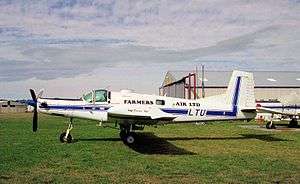PAC Cresco
| PAC Cresco 08-600(750) | |
|---|---|
 | |
| PAC Cresco ZK-LTU | |
| Role | Turboprop |
| Manufacturer | Pacific Aerospace Corporation. |
| First flight | 28 February 1979 |
| Developed from | PAC Fletcher |
| Variants | PAC 750XL |
The PAC Cresco is a turboprop-powered derivative of the FU-24 PAC Fletcher aerial topdressing aircraft, manufactured by the Pacific Aerospace Corporation in Hamilton, New Zealand.
Design and development
The Cresco is a low-wing monoplane which, like the Fletcher but unlike most topdressers, has tricycle undercarriage and places the cabin forward of the hopper, at the leading edge of the wing - which gives the pilot of the Cresco a good field of vision. The high-lift wing has pronounced dihedral on the outer span. The prototype Cresco (ZK-LTP) had an all-moving tailplane, but was lost when the tailplane separated in flight, (the pilot parachuting to safety). Subsequent aircraft have had conventional tails.
Sales of the Cresco were not as impressive as those of the piston-engine powered Fletcher, with only 39 examples being built before production was terminated. The Cresco has been sold in several countries and has pioneered new utility roles not explored by the Fletcher. Although used primarily to spread superphosphate fertiliser, the Cresco is also used in the utility role, especially as a skydiving platform, where its fast rate of climb (1,560 ft/min, 7.9 m/s) has made it popular, and as a firefighting water bomber, a role it can perform with little alteration from its standard agricultural layout. One aircraft has been converted for aeromagnetic survey. A disadvantage in the utility role is the low internal volume available for the relatively high-powered engine.
The Cresco is normally flown by a single pilot, but has a second seat in all versions. It can carry nine (rather cramped) sky divers. Usual powerplant is a 750 hp (560 kW) Pratt & Whitney Canada PT6-34AG.
The PAC 750XL, a utility aircraft aimed at the skydiving market, was derived from the Cresco, and retains its high-lift wing.
Variants
- Cresco 08-600
- Initial production version, powered by 447 kW (600 shp) Lycoming LTP 101-700A-1A engine.[1]
- Cresco 08-750
- More powerful version with 559 kW (750 shp) Pratt & Whitney PT6A-34AG engine. Production from 1992.[1]
Specifications (Cresco 08-600)
Data from Jane's All The World's Aircraft 1988-89 [2]
General characteristics
- Crew: two
- Capacity: up to seven passengers (utility configuration)
- Payload: 1,779 L, (470 US Gallons, 391 Imp gallons) liquid or 1,860 kg (4,100 lb) dry chemicals
- Length: 11.07 m (36 ft 4 in)
- Wingspan: 12.81 m (42 ft 0 in)
- Height: 3.63 m (11 ft 10¾ in)
- Wing area: 27.31 m² (294.0 sq ft)
- Empty weight: 1,270 kg (2,800 lb)
- Max. takeoff weight: 3,175 kg (7,000 lb) (agricultural)
- Powerplant: 1 × Lycoming LTP101-700A-1-A turboprop, 447 kW (600 shp)
Performance
- Never exceed speed: 328 km/h (177 knots, 204 mph)
- Maximum speed: 274 km/h (148 knots, 170 mph) at sea level
- Cruise speed: 250 km/h (135 knots, 155 mph) (75% power)
- Stall speed: 97 km/h (52 knots, 60 mph) at 2,767 kg (6,100 lb) flaps down, power off
- Range: 852 km (460 nm, 529 mi)
- Service ceiling: 5,485 m (18,000 ft) (absolute ceiling)
- Rate of climb: 6.3 m/s (1,245 ft/min)
See also
- Related development
References
- Ewing, Ross and MacPherson, Ross The History of New Zealand Aviation, Heinemann, 1986
- Geelen, Janic The Topdressers NZ Aviation Press. Te Awamutu, 1983.
- Jackson, Paul. Jane's All The World's Aircraft 2003-2004. Coulsdon, UK: Jane's Information Group. ISBN 0-7106-2537-5.
- Knowles, Alan, New Zealand Aircraft, IPL Books, Wellington, 1990.
- Taylor, John W. R. (editor). Jane's All The World's Aircraft 1988-89. Coulsdon, UK: Jane's Defence Data. ISBN 0-7106-0867-5.
External links
| Wikimedia Commons has media related to PAC Cresco. |